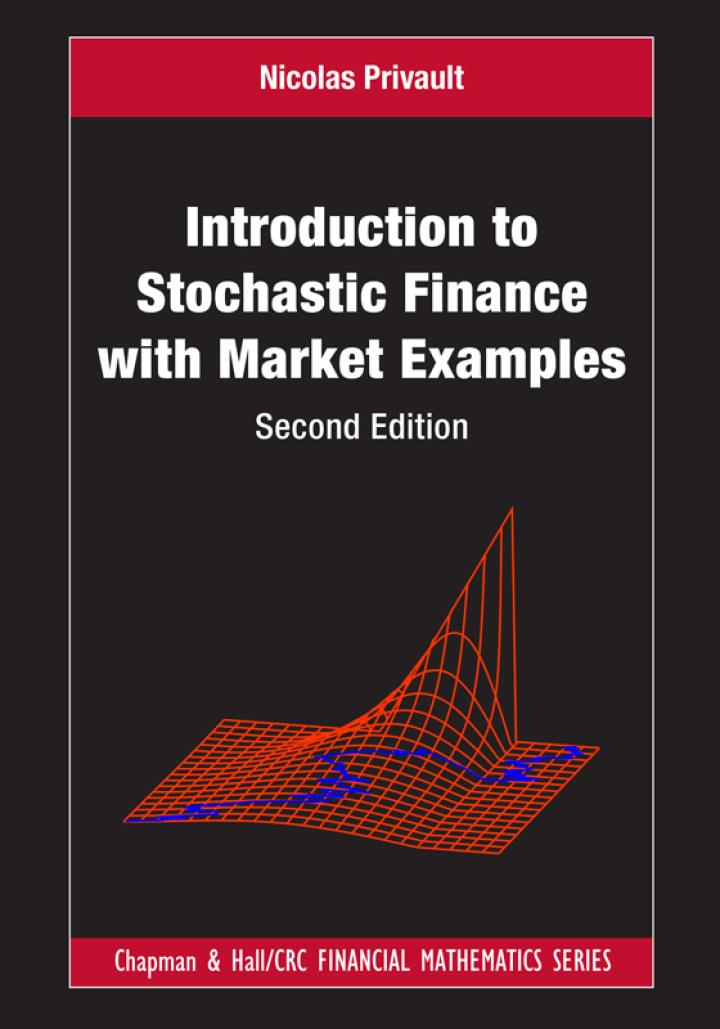An American binary (or digital) call (resp. put) option with maturity (T>0) on an underlying asset process
Question:
An American binary (or digital) call (resp. put) option with maturity \(T>0\) on an underlying asset process \(\left(S_{t}\right)_{t \in \mathbb{R}_{+}}=\left(\mathrm{e}^{r t+\sigma B_{t}-\sigma^{2} t / 2}\right)_{t \in \mathbb{R}_{+}}\)can be exercised at any time \(t \in[0, T]\), at the choice of the option holder.
The call (resp. put) option exercised at time \(t\) yields the payoff \(\mathbb{1}_{[K, \infty)}\left(S_{t}\right)\) (resp. \(\left.\mathbb{1}_{[0, K]}\left(S_{t}\right)\right)\), and the option holder wants to find an exercise strategy that will maximize his payoff.
a) Consider the following possible situations at time \(t\) :
i) \(S_{t} \geqslant K\), ii) \(S_{t} In each case \((i)\) and (ii), tell whether you would choose to exercise the call option immediately, or to wait. b) Consider the following possible situations at time \(t\) : c) The price \(C_{d}^{\mathrm{Am}}\left(t, T, S_{t}\right)\) of an American binary call option is known to satisfy the BlackScholes PDE \[r C_{d}^{\mathrm{Am}}(t, T, x)=\frac{\partial C_{d}^{\mathrm{Am}}}{\partial t}(t, T, x)+r x \frac{\partial C_{d}^{\mathrm{Am}}}{\partial x}(t, T, x)+\frac{1}{2} \sigma^{2} x^{2} \frac{\partial^{2} C_{d}^{\mathrm{Am}}}{\partial x^{2}}(t, T, x) .\] d) The price \(P_{d}^{\mathrm{Am}}\left(t, T, S_{t}\right)\) of an American binary put option is known to satisfy the same Black-Scholes PDE \[\begin{equation*} e) Show that the optimal exercise strategy for the American binary call option with strike price \(K\) is to exercise as soon as the price of the underlying asset reaches the level \(K\), i.e. at time \[\tau_{K}:=\inf \left\{u \geqslant t: S_{u}=K\right\}\] f) Show that the price \(C_{d}^{\mathrm{Am}}\left(t, T, S_{t}\right)\) of the American binary call option is equal to \[\begin{aligned} g) Show that the optimal exercise strategy for the American binary put option with strike price \(K\) is to exercise as soon as the price of the underlying asset reaches the level \(K\), i.e. at time \[\tau_{K}:=\inf \left\{u \geqslant t: S_{u}=K\right\},\] starting from any level \(S_{t} \geqslant K\), and that the price \(P_{d}^{\mathrm{Am}}\left(t, T, S_{t}\right)\) of the American binary put option is \[P_{d}^{\mathrm{Am}}(t, T, x)=\mathbb{E}\left[\mathrm{e}^{-\left(\tau_{K}-t\right) r_{1}} \mathbb{1}_{\left\{\tau_{K} i) Does the standard call-put parity relation hold for American binary options?
i) \(S_{t}>K\), ii) \(S_{t} \leqslant K\).
In each case \((i)\) and (ii), tell whether you would choose to exercise the put option immediately, or to wait.
Based on your answers to Question (a), how would you set the boundary conditions \(C_{d}^{\mathrm{Am}}(t, T, K), 0 \leqslant t
r P_{d}^{\mathrm{Am}}(t, T, x)=\frac{\partial P_{d}^{\mathrm{Am}}}{\partial t}(t, T, x)+r x \frac{\partial P_{d}^{\mathrm{Am}}}{\partial x}(t, T, x)+\frac{1}{2} \sigma^{2} x^{2} \frac{\partial^{2} P_{d}^{\mathrm{Am}}}{\partial x^{2}}(t, T, x) . \tag{15.39}
\end{equation*}\]
Based on your answers to Question (b), how would you set the boundary conditions \(P_{d}^{\mathrm{Am}}(t, T, K), 0 \leqslant t
starting from any level \(S_{t} \leqslant K\), and that the price \(C_{d}^{\operatorname{Am}}\left(t, T, S_{t}\right)\) of the American binary call option is given by \[C_{d}^{\mathrm{Am}}(t, x)=\mathbb{E}\left[\mathrm{e}^{-\left(\tau_{K}-t\right) r} \mathbb{1}_{\left\{\tau_{K}
& C_{d}^{\mathrm{Am}}(t, T, x)=\frac{x}{K} \Phi\left(\frac{\left(r+\sigma^{2} / 2\right)(T-t)+\log (x / K)}{\sigma \sqrt{T-t}}\right) \\
& \quad+\left(\frac{x}{K}\right)^{-2 r / \sigma^{2}} \Phi\left(\frac{-\left(r+\sigma^{2} / 2\right)(T-t)+\log (x / K)}{\sigma \sqrt{T-t}}\right), \quad 0 \leqslant x \leqslant K, \end{aligned}\]
that this formula is consistent with the answer to Question (c), and that it recovers the answer to Question (a) of Exercise 15.10 as \(T\) tends to infinity.
h) Show that the price \(P_{d}^{\mathrm{Am}}\left(t, T, S_{t}\right)\) of the American binary put option is equal to \[\begin{aligned}
& P_{d}^{\mathrm{Am}}(t, T, x)=\frac{x}{K} \Phi\left(\frac{-\left(r+\sigma^{2} / 2\right)(T-t)-\log (x / K)}{\sigma \sqrt{T-t}}\right) \\
& \quad+\left(\frac{x}{K}\right)^{-2 r / \sigma^{2}} \Phi\left(\frac{\left(r+\sigma^{2} / 2\right)(T-t)-\log (x / K)}{\sigma \sqrt{T-t}}\right), \quad x \geqslant K, \end{aligned}\]
that this formula is consistent with the answer to Question (d), and that it recovers the answer to Question (b) of Exercise 15.10 as \(T\) tends to infinity.
Step by Step Answer:

Introduction To Stochastic Finance With Market Examples
ISBN: 9781032288277
2nd Edition
Authors: Nicolas Privault





